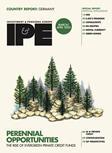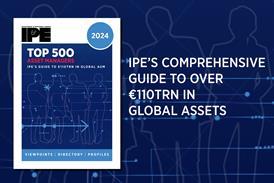All Briefing articles
-
 Features
FeaturesGold’s lustre turns heads as precious metals regain investment safe haven status
Gold, and to a lesser extent silver, have regained their lustre as favoured precious metal safe havens, although there are now new structural drivers.
-
 Features
FeaturesCan emerging market equities offset US headwinds with domestic growth?
Emerging market (EM) equities have been an unloved asset class over the past few years. China’s economic woes, a stronger US dollar and the country’s prolonged tech bull run cast a long shadow. However, there are some bright spots in 2025, despite US president Donald Trump’s tariffs.
-
 Features
FeaturesCentral banks and cryptocurrency reserve: set for a breakthrough?
After courting the crypto community during his presidential campaign, Donald Trump issued an executive order in early March to create a US strategic bitcoin reserve, as well as a national digital assets stockpile of tokens other than bitcoin.
-
 Features
FeaturesAnother strong year ahead for green bond market as EU regulations set to drive demand
Against all the odds, the green bond market had a good 2024. In a year when inflows into global sustainability funds were slashed in half, green bonds recorded their second-highest annual issuance levels ever, with more than $560bn (€536bn) of labelled paper sold
-
Features
Central & Eastern Europe pension plans still not integral to employment benefits
CEE has no tradition of employer pension responsibility Most countries lack collectively bargained agreements New systems are being rolled out but many are still in the adoption phase
-
Features
Cross-border investment barriers: issues for institutional investors
Protectionist trade policies are back in vogue, fuelled by the rise of China’s economy and, more recently, by the escalation of geopolitical tensions.
-
 Features
FeaturesBriefing: The challenge of investing in Europe’s energy transition
The way the European economy powers itself is undergoing a fundamental shift, driven by market forces and policymakers. But while the direction of travel is clear, the path to a different energy mix is tortuous and the shift may be much slower than required to meet Europe’s target to be net zero by 2050.
-
 Features
FeaturesInsurance-linked securities bank a stellar year for returns
Insurance-linked securities (ILS) may be complicated, but they are gaining an institutional following especially among pension and sovereign wealth funds, multi-asset investment firms and endowments.
-
 Analysis
AnalysisPan-European personal pension product requires improvement
Funded pensions can provide both a retirement income for EU citizens and capital for long-term investments by financial institutions.
-
 Features
FeaturesMarket looks to Xi Jinping for a plan to boost China’s economy
When the Chinese government announced a package of measures designed to revitalise the domestic economy in late September, the country’s stock markets responded positively, and many breathed a sigh of relief.
-
 Features
FeaturesUS high yield bonds punch out of a corner
US high yield has come a long way from its murky beginnings with the very high yielding bonds of so called ‘fallen angels’, and Drexel Burnham Lambert’s Michael Milken offering bonds newly issued by corporates with sub-investment grade ratings for the first time in the 1980s, properly introducing the world to high yield bond investing.
-
 Features
FeaturesNAV finance takes hold as a niche form of private credit
Private equity investments are by their nature illiquid, which is why PE general partners (GPs) raising a new fund only call on the committed capital when it needs to be deployed in a new investment – and that may be up to a few years after the fund closes.
-
 Features
FeaturesSecondary markets and innovation boost private equity liquidity
Liquidity has reduced significantly in global private capital markets. Whilst private equity-backed IPOs are up this year, overall exit value is down by 66% and there is currently a large backlog of unsold assets, of which 40% are four years or older. The cumulative sum of unsold assets sits at $3.2trn (€2.9trn), according to Bain. Recent data from Preqin shows that capital called has exceeded capital distributed by $1.57trn since 2018, highlighting the lack of free capital in private markets.
-
 Features
FeaturesCyber catastrophe bonds make a debut as insurers offload risk
Cyber catastrophe bonds may be the new kid on the insurance-linked securities (ILS) block, but they have been talked about for years. The jury is out, though, as to whether they will follow the same trajectory as their natural cat bond peers. While some analysts believe they have the potential to go mainstream, others cite concerns over modelling and lack of diversification.
-
 Features
FeaturesHow the EU's pay transparency directive affects pension sponsors
Pay transparency is looking set to be the employment hot topic of at least the next few years and reflects an ongoing global conversation around addressing equal pay. The latest figures in the EU put the gender pay gap at around 12.7% and the gender pension gap at in excess of 30%, with very little movement over the last few years. Greater transparency over pay is the route being adopted in a growing number of countries as the silver bullet to accelerate progress.
-
 Features
FeaturesCorporate transition plans need to spell out net-zero dependencies
Corporate climate transition plans are gaining momentum globally. Essentially, these are reports about how a company plans to achieve emission reduction targets, but the idea is that the company will have engaged in strategic thinking and planning to produce such a plan, rather than just churn out more disclosures.
-
 Features
FeaturesT+1 settlement rules pose challenges for fund managers
A global move to compress settlement cycles – that is, the time between when a transaction is agreed and executed and when the transaction is completed and the securities and cash are exchanged – is underway. While the aim is to deliver lowered risk and cost savings, investors and market participants face challenges due to the increasingly interconnected nature of financial markets.
-
 Features
FeaturesUK creates social factors template for pension investors
Environmental and governance risks receive much attention, but UK and other European institutional investors have focused less on social factors and their complexities.
-
 Features
FeaturesPrivate credit secondaries come of age
Since the secondaries market came into existence, private equity has been the dominant asset class, but the tide is turning. It is finally time for private equity’s more youthful counterpart, private credit, to receive more of our attention. The private credit secondaries market borrows various elements from its older sibling, including best practices and deal structures, and it is now demanding the spotlight as awareness of the asset class increases.
-
 Features
FeaturesInvestors are paying for hedge funds' reluctance to use hurdle rates
Although two years have now passed since the US Federal Reserve started rapidly hiking interest rates, the likelihood that your hedge fund manager will have a ‘hurdle rate’ – a minimum rate of return before performance fees kick in – has not changed. Only a quarter of hedge funds, by our count, have such a threshold in place and the practice does not yet show signs of becoming more widespread, even though the risk-free rate has now exceeded 4% for well over a year.












